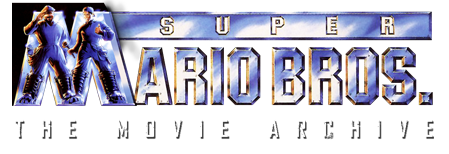Exclusive Interviews
Mark McCoy - SMB Archive Interview: 07/02/2008 by Ryan Hoss

Mark McCoy, who worked on some of the special effects in our favorite Super Mario Bros. movie (his main job was making all of the fungus!), shot me an email, willing and able to help out with my website's mission. What follows is an interview that was conducted in July of 2008 through instant messenger.
Ryan Hoss: First of all, I really want to thank you for finding the website and wanting to do something like this. There are just so many fans of Super Mario Bros., and there just isn't enough behind-the-scenes information (or anything really) for us.
Mark McCoy: No problem. I think I found the site by accident when someone on another forum that deals with props asked me a question I did not know the answer to. I did a quick Google search and there you were.
RH: Ah, that's very interesting. I guess SMB Archive is really getting out there.
MM: Yeah, I think you were on the first page of rankings. Like you said though, not a lot of info out there on the subject so you might have been on a "short list.” : )
RH: Yeah, the website is really the only of its kind. But I have so much stuff I want to accomplish for the website, because the movie is really something people need to look into. I think so much thought and effort went into making it, and I think that really gets overlooked.
MM: I think it was one of the first, if not THE first arcade game to movie experiment that Hollywood attempted in any serious way.
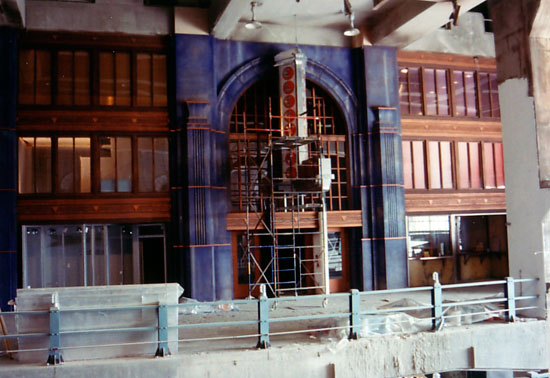
Koopa Square being constructed. Notice the "Koopa Electric Company" sign being installed
RH: Yeah, it was the first motion picture based on a video game. And honestly, the movie turned out to be something amazing, especially when you consider that was the first time anyone tried to do something like that. Everything from the ambition, the script, and the Blade Runner-like direction of the movie was just very intriguing, in my opinion. I mean, some people don't like it because it's not EXACTLY like the game, but who wants to watch a cartoon movie where a little red guy jumps on people's heads?
MM: I agree. Not sure I'd go so far as to call the directing Blade Runner like, though. Having two directors on a film, much less one as complex and innovative as this one, can only lead to a lot of indecision and a general feeling of "lack of organization" on the crew's part.
RH: Not necessarily Blade Runner directing, but certainly Blade Runner prop/sensibilities, and art direction. After all, David L. Snyder was the production designer on both movies.
MM: I’ll give you that. The overall look of the film was a lot like Blade Runner. Having to work from a video game versus a proposed real city in Blade Runner, did have its challenges I would guess. Not sure what we would have ended up if Syd Meade had been able to do some of the concept work on Mario as well.
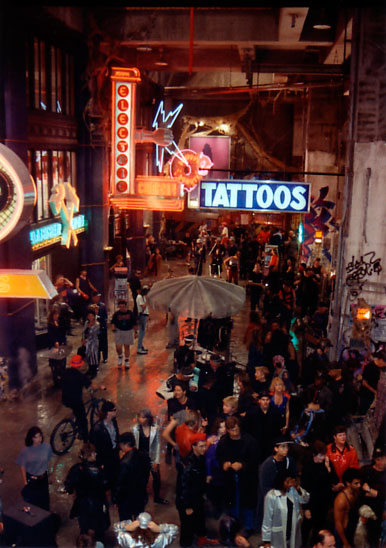
"Having to work from a video game versus a proposed real city in Blade Runner, did have its challenges I would guess."
RH: Agreed. Perhaps if the movie had a solid direction, a "champion," if you will, it would've come out smoother. I really think you can see the potential when you watch the film. So Mark, how did you get into the entertainment business?
MM: Like many in the field, by a lucky accident. You have to really want it of course, and I did, at the time. I went to school for computer graphics at first, but when the small school I had chosen lost their funding for the computer science major I was in, I decided to transfer to a school up in Northern Minnesota. I decided I wanted to build models and go work for Lucasfilm on the next Star Wars or something. Total fanboy! : ) Long story short, by the time I graduated with a B.S. in Industrial Technology with an emphasis on model making, Lucas had just begun pioneering his soon-to-be digital empire. They say hindsight is 20/20. Should have stuck with computers. I came down here to Wilmington, NC on a summer trip with my folks and was staying with my cousin. She was a realtor for a large company that did housing for the film industry that was here at the time. We have the largest studio lot in the country here, east of L.A. Anyway, my cousin was in touch with the production office of a small movie called T-Bone 'N' Weasel with Christopher Lloyd and the late Gregory Hines. A job opened up for a second assistant in the sound department, and I was asked if I wanted it. You take whatever opening you can get to break into this industry, so I did. My folks went home, I never did.
RH: Oh wow, that's a very interesting story. A lot of movies are shot in Wilmington, aren't there? I've heard it's a very nice, very friendly and cooperative town for productions that shoot there.
MM: It can be. I've been here since 1991, and have seen a lot. There are still the locals that say they hate it when a film is here, and bitch and complain that a street gets closed off and they have to detour to get to their local Starbucks or something. But, most of the people here like it and a lot come out and be extras in the films. We have a number of casting agents here that do nothing but organize extra casting for just such the occasion. On a side note, the studio I mentioned used to be DEG Studios when Dino De Laurentiis built it in the 80s to do Firestarter with a young Drew Barrymore. Later on, it was bought out by Carolco. It is now owned by Screen Gems and they shoot One Tree Hill here now, and before that it was Dawson’s Creek and Surface.
RH: Neat, Wilmington sounds like a wonderful place. And that brings us into Super Mario Bros. As I'm sure many fans know, that's where the movie was filmed. How did you get involved with the production?
MM: Again, thanks to my cousin. She had to go on set one day to talk to the accountant. I tagged along in hopes of seeing the set. As the three of us were walking and talking, the accountant asked me what I wanted to do, and I told her I was interested in "Special Effects", actually mistakenly meaning "Visual Effects." Some ten minutes later, we are going through the shops on our way to the set, and she introduces me to Paul Lombardi. (His father, Joe, worked with A.D. Flowers on all of the explosions for "Apocalypse Now"). She asked Paul, "You got anything this guy can help you out with?" As they were just crewing up for all of the fungus, he said “yes”, and off I went.
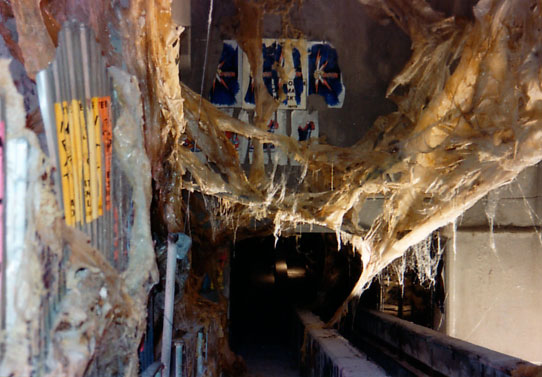
"As they were just crewing up for all of the fungus, he said “yes”, and off I went."
RH: Wow, that's amazing. So you went to school for computers at first, and went to model building; then you meant to get into visual effects and mistakenly got back into the practical side of things?
MM: Yep. I still love the practical side over the visual side too. CG has come a very long way since then, but I can usually tell when it’s not real. Just something you get a feel for when you know what to look for. I wish Hollywood could see that and go back to a more practical approach on some of their effects work. "Digital" is still the new toy in the toy box, but more often than not, is more expensive to do and takes longer to realize than a practical effect.
RH: I think, especially now, that a lot of people have become very jaded and used to seeing CG effects. I think practical effects are beginning to make a comeback, though; lots of stunts and things in recent movies like The Dark Knight were done practically. So what was your official title in the credits?
MM: Ah, the credits, a sore subject. There were five of us in total that were responsible for ALL of the fungus in the movie. When they did a premiere for us here in town the week before it opened, they gave us all souvenir brochures of the cast and crew. Of course we all looked through it to see where we were. In short, we weren't! : ( We figured, “Okay, maybe they didn't have the entire crew list before printing these up and we would be in the screen credits.” "Damn-it!" We were p-o'ed. Our boss, one of the art coordinators, Simon Murton, was listed, but none of us were. That has since been corrected on the IMDB, but it still stings a bit. To answer your question though, on the call sheet we were listed as “Fungineers."
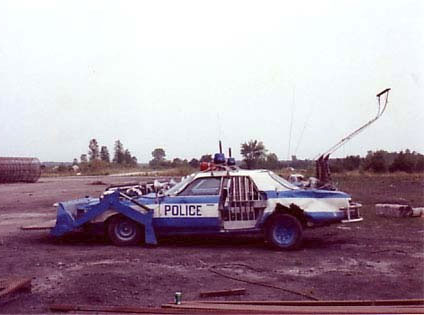
Mark assisted in making some of the detail parts for the police cruisers
RH: Ah, interesting. That's such a shame that you Fungineers weren’t credited. Without you guys there wouldn't have been any fungus! That was really integral to the grungy and grimy look of the movie. I know you've mentioned fungus, but what kinds of other tasks were you involved in?
MM: Fungus was pretty much 90% of what we were called on to do. There was the odd task of repairing some of the foam rubber "Thwomp" boots from time to time, or aiding the set dressers with our fungus application. I help out with some of the prop work from time to time as well. All of that was very incidental though compared to the fungus though.
RH: So let’s hear it: exactly how does one construct some Dinohatten fungus? I mean, other than de-evolving the king?
MM: Yeah, poor Lance. He had it rough. : ) There were three types of fungus we made. The small stuff that looked wet and gooey that you saw some of the small dinosaurs eating was made from the same stuff that they make those fishing worms out of. It’s a high temp vinyl that can be colored any way you like. We heated it up and drizzled it into a pool of cold water to get long "fungus boogers." Next up was the larger, netting-style fungus and that was also done with a large pool of water. We had a shallow tank about 4 x 8 feet, crisscrossed with a series of monofilament fishing line. We then proceeded to "squirt" long trails of hot melt glue into the pool and over the grid of line. The glue would stick to the line and harden almost immediately in the cold water. Clip the lines at the edges and lift out a large net of fungus that could be cut and draped anywhere you wanted. The rest was all done with large sheets of milky white plastic commonly used to cover up large areas on a field or garden. We tied it off at a particular height, and using bailing wire we sculpted it into a basic shape. Then the fun part—FIRE! We hit it with portable flame throwers, believe it or not. It melted the plastic just enough to make it look fungus-like and give it that freshly stepped in "chewing gum" look. A quick coloring of brownish-red stain applied with a garden sprayer, and it was ready to go.
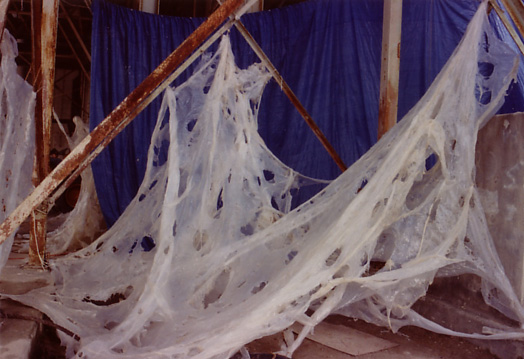
How to make fungus--stage I. Plastic with holes burned into it
RH: Neat, there did look like there were many types of fungus to have to work with in the film. Did you get to add things like the little mushrooms or the occasional Bob-omb?
MM: The mushrooms were sculpted and cast out of resin and placed wherever needed. The stems were also fishing line, 160 lb test I believe. The Bob-omb was made by a talented model maker by the name of Gus Ramsden. I think it was made from the inner workings of a "Fry Guy" wind-up toy from a Happy meal, and put inside a ping pong ball. I might have the ball part wrong, not sure. Gus was also responsible for making the crystal shard that was used to "heal" the worlds.
RH: Oh, for a second there you had me thinking "Fry Guy," like the Super Mario Bros. character—I think that was actually the brand of flamethrowers in Dinohatten, yes? How was the meteorite shard made?
MM: That was sculpted out of clay like the mushroom. A mold is then made from silicone rubber and a clear casting resin is poured in. For the shard, it has a tinge of blue to it with a dark blue patch near the top. It also has a slight glittering applied to it. The glitter I believe was brushed onto the mold before the resin was poured in. The blue dye was dropped in last and "pushed" down with a small stick to give it a semi swirled look. The top was then finished off with the cord wrapping.
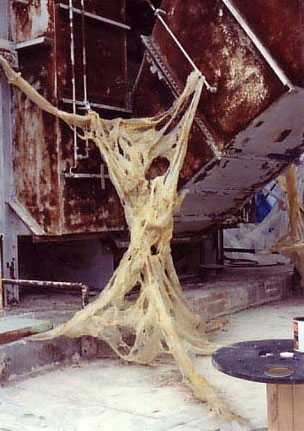
How to make fungus--stage II. Plastic sprayed with yellow shellac
RH: I'd love to have "the rock," haha. You've mentioned using things like fishing line, plastic, etc. Was there anything else special-effects related that looks really cool on-screen, but was actually very easy or simple to achieve?
MM: Yeah, I have one of the "rocks" that was not used. Pretty neat. Not much comes to mind on that except maybe the flame throwers that shot the balls of fire across the city. The effects guys had some sort of flammable ball on a long wire and they were "flung" across hard enough to slide along the wire and then explode when they hit the wall on the other side.
RH: That sounds simple enough. We've talked about these a little, but I'd really like to talk more about one of my favorite things in the movie, by far: Thwomp Stompers.
MM: Those were fun to play with. I did not have anything to do with the practical ones, but I did repair the foam rubber ones from time to time. The "real" ones were sculpted in Los Angeles and used, I believe, a "Lange" ski boot as a base. There was a hinged part that opened and closed across the ankle area and a flip open part that went over the toe area. Just above that there was a sequence of red lights that was controlled from off screen by an operator. The back of the boots had a place for a cartridge type projectile known as "Bullet Bill." These looked kind of like the large grenades Arnold loads into his gun in T2. These "Hero" boots were only used for close-ups and not for walking around in. All movement was done wearing the many copies of foam rubber versions.
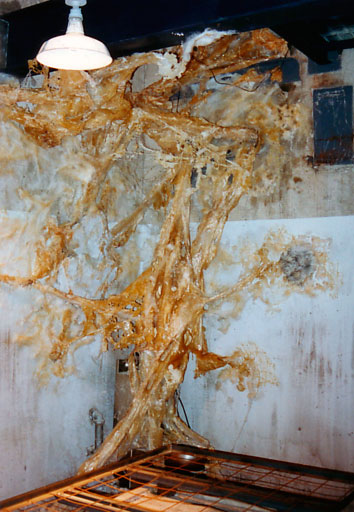
How to make fungus--stage III. Final touch-ups and more color depth
RH: Yeah, I figured that there were a version that did all of the tricks and "jumping," and another for walking. I wonder how comfortable they were to walk around in?
MM: WOW! Almost forgot one of the fungus types. First we took very large sheets of latex. We made a large field of plaster in a shallow mold and painted it with many coats of liquid latex to give it strength. One of the sheets was almost 10 feet square and was used in the scene where Luigi is hanging from the hook and Mario tries to save him.
RH: Oh, like a trampoline? That was a fun scene.
MM: That's the one.
RH: So I'd take it that the foam rubber Thwomp Stompers were made in bulk because they kept falling apart?
MM: Not so much bulk, but yes, I think there were 5 to 8 pairs made. They did suffer wear and tear on the bottoms and the flaps that went around the ankles; foam rubber is not a very durable thing.
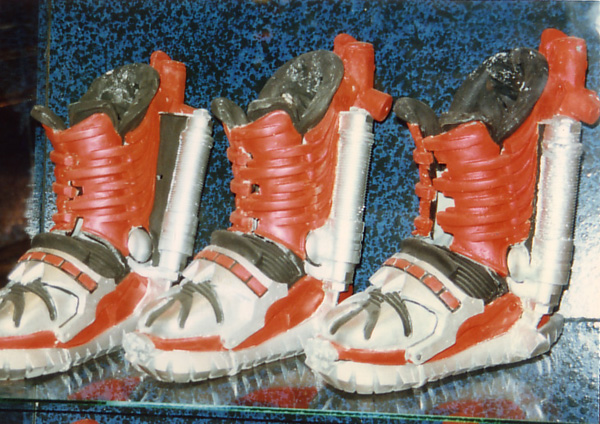
Foam rubber Thwomp Stompers in all their glory
RH: Doesn't it also degrade over time?
MM: Yes it does. It dries out too much and becomes flaky if it is not covered in something. The boots were painted with a latex based paint to help minimize this.
RH: I suppose that's one reason you don't really see any of those props popping up on any auction sites anywhere. Plus, who would want to sell something so neat?
MM: Most of them got trashed in the dumpster, believe it or not. One of the FX guys rescued a pair though. Years later, He asked me to broker a sale of them. I think they went for around $400. Low ball for an authentic screen used movie collectible, in my opinion.
RH: Honestly, I wish I knew what dumpster to go dig in to find them, haha. Have you ever thought of attempting to recreate a pair of them (or any other props from the movie, for that matter), just for fun?
MM: I wouldn't be able to do them justice, I'm afraid. My sculpting skills are pretty rusty. I suppose I could cast copies of the "rock" if I wanted to.
RH: That would be fun! Did you get to work with/see Yoshi in action? I think he really holds up, and still looks very realistic. I’m not sure about this by today’s standards, but at the time I believe it was the most advanced (and expensive) animatronic creation for a movie.
MM: I think you're right. One of the people on the forum asked if he could stand and walk by himself. The answer is "yes.” He did have a bunch of control cables that came out of his backside though that may have helped him balance though. I remember seeing him on set being walked around by the puppeteers. Pretty darned cool.
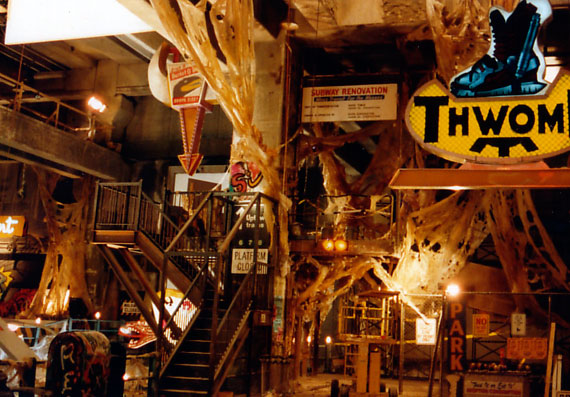
This is a cool angle of Koopa Square. Didn't see this one much in the film itself
RH: That must've been amazing to see something like that in person. Did you get to see anything involved with the climax of the film, where Koopa turns into a full-blown T-Rex?
MM: I think that was all done digitally.
[Interviewer's note: "The Demise of King Koopa" sequence was realized with a series of animatronic puppets designed and supervised by Patrick Tatopoulos, with Rob Burman and Bud McGrew handling the prosthetics and mechanics, respectively. The "stages" of Koopa's de-evolution were then digitally blended and morphed with CG during post-production.]
RH: I think most of it was, at least. So did you come into the production during pre-production stages, or were they already filming?
MM: I arrived about the middle of preproduction. The city sets were still being built when I got there, and of course, no fungus. The whole entire set, inside and out was built out on location in Castle Hayne, NC at a place called "Ideal Cement Factory." If anyone wants to go there in Google Maps, type this in.
RH: It seems like such a HUGE place. If I remember correctly, 100% of the movie was shot here, and in downtown Wilmington? And almost all (if not all) of the effects, editing departments, etc. were located in the factory as well?
MM: All of it was done on-site at the factory. I don't recall anything being downtown though and I imagine editing was done in Los Angeles. But yes, all of the departments were based out of there. If you look at the picture, you can see the tall tower structure off to the right. Between it and the building is all of the open girder work that we dressed with the latex fungus for the trampoline stunt. Way to the right and down a bit is the actual quarry bed where the ore is dug from the ground. This is also the "Koopahari Desert," which is located near the middle, where you see the five tall towers. The concrete road below that and to the left is the entrance to the tunnel where Mario and Luigi drive to escape the city.
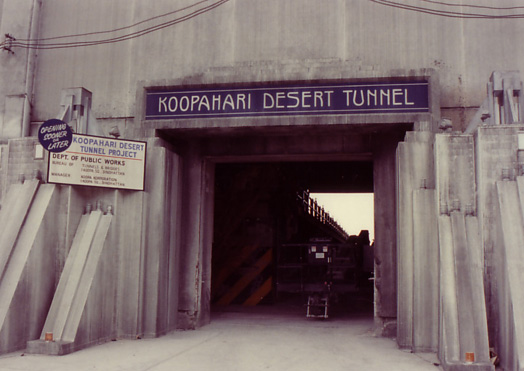
Koopahari Desert Tunnel Entrance
RH: Weren't Mario and Luigi's apartment and the Italian restaurant also inside the factory somewhere?
MM: Nope. That was all shot on location in NYC. Wilmington was used for the alternate reality world. There is one scene I think where Luigi is on the phone after the truck breaks down. That was downtown Wilmington, now that I think about it. There is a shoe store across the street that is still there. As I was in the FX department, I am not sure of all the locations they used. You are probably right in the fact that other areas of town were used. I’ll have to look when I go watch it again.
RH: I believe that one of the books I have, Microchips and Moviestars: the Making of Super Mario Bros. says that Wilmington doubled for a lot of NYC locations used at the beginning of the film. Out of curiosity, when was the last time you saw the film?
MM: Quite possible. I watched it about a year ago I think. I went through my whole collection of local movies one weekend.
RH: That sounds really fun. I wish Super Mario Bros. would be released in HD so we could see a lot of this background effects/prop work in more detail.
MM: I wouldn't hold my breath. : )
RH: I know it's a long shot, but I thought it would never be released on DVD, either. : ) Is the cement factory still standing?
MM: It’s still there. In fact, it’s in the process of being bought out by a huge corporation named "Titan.” The locals don't want it due to the pollution hazard. The existing quarry is still used, but they do not make cement there anymore.
RH: It was abandoned before Super Mario Bros. was filmed, wasn't it? Was everything movie-related destroyed and torn down after production?
MM: Everything that we put up was taken down. The site is still an active quarry, but no cement manufacturing is done there anymore.
RH: Everything? Not even maybe some barren Dinohatten storefronts or something?
MM: Not as far as I know. We filled many a dumpster for two solid weeks. The production re-hired many crew personnel strictly for demolition work after we wrapped.
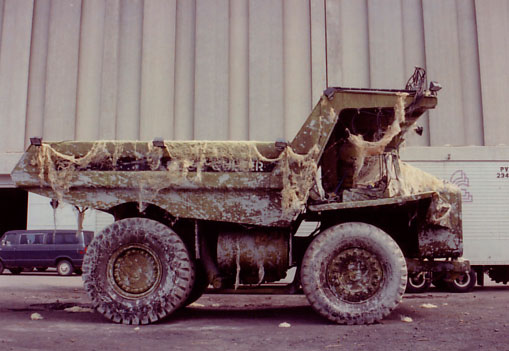
"We filled many a dumpster for two solid weeks." What a shame!
RH: Wow. I think that's pretty interesting seeing as how the place was really kind of cleaned up for the movie, right?
MM: Yes. We had to make the structure "liveable." Walls were constructed for all of our offices and shops, as well as the actual shooting sets. Room sizes were dictated by the space between a lot of he girders that made up the buildings.
RH: You know, that brings up an interesting question: was there ever talk of a sequel? Of course, the movie ends with the most blatant set-up for one, but why would they do something like that when all of the sets were torn down?
MM: Hollywood will always, it seems, try to make a sequel of its properties if it thinks it can make more money. I never heard talk of a sequel while working, but the scene in question screams for one. Then, there is the fact that Wilmington is a "location" for filming. We're not in the L.A. definition of a premier spot. They could have planned to move any sequel production back to L.A. and completely re-build everything.
RH: That's true I guess, but wasn't everything (sets, shops, prop crew, etc.) inside the factory to cut down on costs? Seems like they would be shooting themselves in the foot having to do everything over again. I wonder if there was ever a treatment (or script, even) written for a second movie...
MM: Hollywood doesn't do anything unless it thinks it can make money. Any mention of a sequel while filming the first one would be pre-mature in my opinion. It was a big gamble to turn a video game into a movie in the first place. Add on top of that an all but untried (duo) of directors that only had Max Headroom under their belts, and you have way to many "if's" to guarantee a profitable sequel. You can however write the hook into the script "just in case." I do not know of any proposed sequel script floating around out there.
RH: A lot of that makes sense. One last question about the cement factory: is the main part abandoned? Can you visit it or go inside or anything?
MM: As far as I know, the site is vacant, not abandoned. It is currently being sold to "Titan" in hopes of returning it to a working factory.
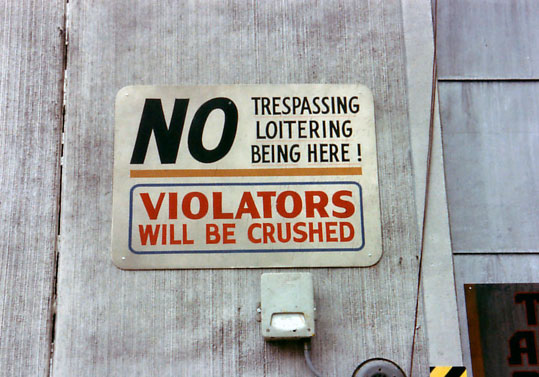
I wonder if this would happen to me if I tried to visit the cement factory today
RH: Ah. Did you have any exposure to the script or story beforehand? I’ve read rumors that there was a script at one point that was more “fantasy” based, say, more like Willow than Blade Runner.
[Interviewer’s Note: this interview was conducted before we actually did find the “fantasy” based script. Click here for more info on that.]
MM: No. I did not even get to read the script in its entirety until after we wrapped. We got what they call "sides" for each day’s filming. It’s basicly a miniaturized version of just the pages that deal with what you have on that day. I was able to get a copy of the whole thing from the production office when we finished. I have scripts from every show I have ever worked on.
RH: Oh, that's really nice. Just a side note—is yours the finished shooting script or an earlier draft? I somehow managed to get an early draft of the script dated March 25, 1992. What date is yours? And do you remember the timeframe when you guys filmed the movie? That could shed some light on how "early" my draft really is.
MM: The cover page on mine says April 23rd. It has many pink and blue pages in it denoting place where a scene was changed, so there is no telling what date it really is. My first paycheck says May 23rd though. :)
RH: Heh, cool. Just wondering because my script is WAY different than what ended up on film. Like, WAY different. Revised by Dick Clement and Ian la Frenais? Not even guys with the final writing credits. Perhaps we could compare our scripts :) I've been wanting to share it with everyone on the site, but I'm not sure if I'd get in trouble for posting the thing in its entirety.
MM: I doubt anyone associated with the production would care. Not sure how you would get it into electronic form unless you retype it. Mine is a bit blurry for any sort of OCR software to make heads or tails of it.
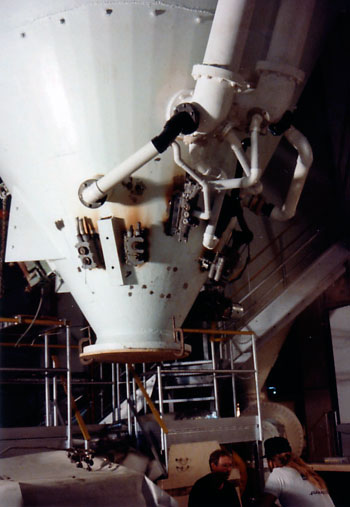
The De-Evolution chamber, in construction
RH: Yeah see, that's what I was figuring. It even has the Lightmotive phone numbers and stuff on it. I've contemplated calling them to see if they could shed any light on it or somehow by an act of God grant me access to other script versions, but I haven't. Mine is a remarkably clean copy, but I figured I'd just retype it myself.
MM: The lightmotive number is in all likelihood, a dead number. Most productions set up contact info for that show and that location only and then shut them down after wrap.
RH: Yeah, I figured as much anyway. I think I ran across their website a couple of years ago, not sure if it's still active or not. So let's get into more of your experiences on the film. I recall you mentioning that you came into the film during pre-production, but how long before shooting started did you get to work on things?
MM: Pre-production for me was about a month and a half. Probably close to 3 months for the initial production office people.
RH: That puts things in some better perspective. Did you get to be in the movie at all?
MM: Nope.
RH: Aww, what a shame. Who were your favorite people to work with on the movie?
MM: I was in the FX department, so I got very little interaction with the cast. I did meet Bob [Hoskins] and John [Leguizamo] though. Nice guys, both of them.
RH: Oh really? Cool! How were they?
MM: Like I said, very nice. Contrary to what a lot of people may think, everyone doesn't get to hang around when the cameras are not rolling. The only time you may get a break is when we go to lunch. You usually meet and talk while on the way to or from a set. You're lucky if you get two minutes to talk to anyone "above the line." That term refers to the pay scale by the way.
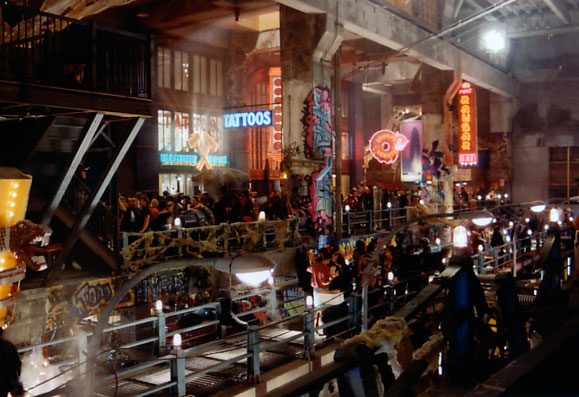
Koopa Square in all its glory
RH: Yeah, that's what I figured. Nice that you got to meet them, though. Many articles and stories I’ve read point to great turmoil on the set (not only dealing with the directors, but the potential health hazard of the factory). Could you shed any light on that?
MM: No health hazards were brought my our attention that I can recall. However, Since the whole thing with "Titan" on buying the facility has come up, the locals are all saying what a big health problem having a working cement plant could be. As for the directors, thats a whole 'nother thing. There is usually tension on the set between a Producer and a Director. This invariably rubs off and trickles down to the crew. This show had TWO directors. You do the math. We affectionately referred to the movie as "The Rocky and Annabelle Show."
RH: Oh so the producers had a totally different vision than the directors did?
MM: Don't know if it was different, but they are the ones who control the money. Trying to stay on a schedule and not go over budget is their primary job. When the day runs long, everyone gets overtime. Gotta wonder if it was really worth it to set up for that last shot or try for that other angle "just because."
RH: Hmm. So did the directors ever get on some sort of equilibrium at one point? It doesn't look like it did—Hoskins and Leguizamo have said some pretty downright nasty things about them in autobiographies/interviews/etc.
MM: Not so far as I could tell. I have read some pretty bad press too. I believe they were dating each other so I'm sure there was sort of synergy going on, but it rarely ever made it to the set.
RH: They were husband and wife (I think they still are).
MM: Could be. I don't recall.
RH: I’ve also heard that Morton and Jankel either quit, left, or got fired towards the end of the production, and that Roland Joffe (Producer) and Dean Semler (Director of Photography) had to fill in to finish the film.
MM: Might have been during post production that they were let go. I do remember tensions being pretty high towards the end or principal photography.
RH: Do you think that compromised the film's potential?
MM: I couldn't begin to calculate how much, but I am sure it did.
RH: One last question about them, from a forum member (ultimateemail5000): Do you know (or were you) the guy who got splashed with hot coffee when Rocky Morton didn't like a design somebody came up with?
[Interviewer’s Note: Mystery solved—read my interview with Jeff Goodwin for more info on that.]
MM: Nope, not me. Probably someone up in the Art Department.
RH: Heh. Do you have any interesting stories or recollections from working on the film that you would like to share?
MM: It was the first "real" movie I got to work on, instead of a made for TV thing. I was just overloaded with everything going on it was hard to keep track at times. I do remember going exploring with one of the other "Fungineers" one day during lunch. We roamed all over that place and into places that were not going to be filmed; some were even too dangerous to even be on, but hey....I even remember being in the cement auger that doubled as the underground tunnel to the cave. We went in there before it was dressed for filming and walked the entire length of it.
RH: Oh, so the big tunnel in the picture you sent actually is the tunnel in the movie that leads to the meteorite chamber/bridge between worlds?
MM: No. That was clever editing I'm afraid. The tunnel end that was dressed for the "Scapelli" flood scene is what I am referring to.

Archaeologic excavation tunnel set
RH: Oh, right. That's still pretty cool, though :) So how did everything get wrapped up? On the last day of filming, was everyone happy/excited/glad it was over?
MM: On something this big, it usually a slow wind down rather than an abrupt halt. Our FX shop was clearing out as some of the final scenes were still being shot. It’s all in the name of conserving money. No sense in keeping crew idle while someone else is still working. And like I said before, most of us were re-hired right after to help out with all the demo work.
RH: Right. So here's another forum member question (from marioblaster): Do you still keep in touch with the cast and crew members? Write them letters and keep correspondence?
MM: The ones I worked with I have had next to no contact. Some of the model makers I run into from time to time. I did work recently with one of the other "Fungineers" recently on the TV series Surface. It’s a pretty small town when it comes to the film industry, so you run into everyone again, eventually.
RH: Right, I would assume that with Wilmington being a flim town like that. Are there any deleted or extended scenes that you know about?
MM: I think there are some extended scenes on the DVD, but nothing deleted comes to mind.
RH: That's one thing I'm trying to find confirmation on. Lots of things on trading cards, novel, scripts, etc. point to some major things, like a longer backstory with the Scapelli plumbers, etc.
MM: Could all be speculation based on previous drafts of the script.
RH: Some of it is, I'm sure. But some things tie in really well with the script, like we have multiple screenshots of Doug and Mike (the Scapelli plumbers) inside the restaurant, with Mario and Luigi. But anyway, another question (from marioblaster): What do your family and friends think of the film?
MM: My folks thought it was "fun.” As for my friends, most of them are very critical of films in general. They will pick a movie apart if they get the chance. For what it was and when it was shot, I think the movie is great. If it were done today, I think it would take on a whole new perspective. A lot more effects, and I am sure the whole alternate world thing would have been completely in digital.
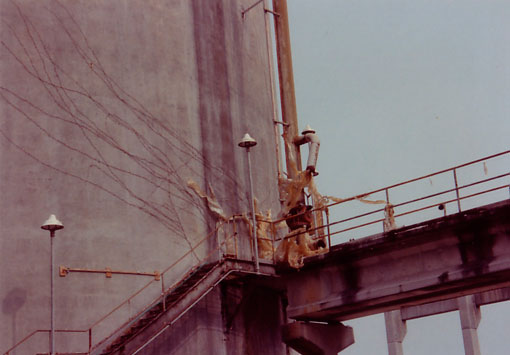
"Cops! Goombas! Daisy! The rock!"
RH: I agree with all of that. And as I've said before, if you have a certain perspective when watching this movie, it really does kind of stand on its own as a very ambitious project, to say the least. I know there are many reasons that the film didn’t perform so well at the box office (such as poor marketing, advertising, being too “dark” for kids, being released on the same weekend as Jurassic Park, and a general misunderstanding of the film), but what do you think the biggest reason was?
MM: I think people were not sure what to expect from a video game turned movie. Your core audience were gamers and fans of the game. If they were not happy, the movie was going to fail. Not being a gamer myself, I cannot speak to their frame of mind or expectations. If you were not into the game, you probably had no great desire to go see it in the first place and would have waited for the "buzz" to make up your mind.
RH: Right, exactly. One thing though is I think that people forget the fact that this film was released in 1993, and based on that fact alone I think they did a really good job of putting as many game references (especially Yoshi, since he was a very new character at the time) and making a storyline something more than a guy in a red suit jumping on people's heads.
MM: True. As I said, I was not a gamer. I think I only had a slight understanding of the concept of the game myself at the time.
RH: Right. So they did a premere for the movie in Wilmington?
MM: Yes they did. They closed down a small theater just for the local crew.
RH: Was that the first time you saw the completed film?
MM: Yes.
RH: What did you think of the finished product when you saw it for the first time?
MM: I loved it. But like i said earlier, a little bit upset not to see my name in the final credits.
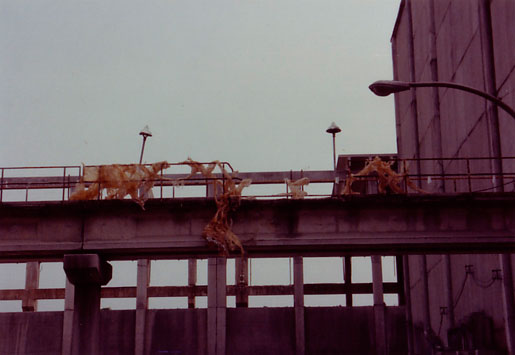
"The tower! A sludge-gulper! Jump! Okay!"
RH: Oh yeah, I would've been pretty upset as well. Hopefully this interview will get you some of the recognition you (and the rest of the Fungineers) deserve. Last question, Mark. What do you think about the film and your experiences with it now?
MM: I count this film as one of the best times I have had thus far. It was a lot of hard work, and I got mad on more than one occasion at people that did not deserve it. There were more than a few times when everyone was on edge, but I wouldn't trade it for anything.
RH: It certainly sounds like you had a very gratifying (if not always pleasant) experience working on Super Mario Bros.
MM: Yes I did. It opened more than a few doors for me for future projects.
RH: Well Mark, I can't thank you enough for taking the time to do this interview; it has been a very interesting, pleasant, and eye-opening experience. You've really shed some light on this very interesting and misunderstood film, in my opinion. Have anything else to add?
MM: Thank you for your time as well. I hope it answers at least a few questions people have had over the years. Let me know if I can be of any help in the future.
RH: Sure! Honestly, this was really great getting to talk to you. Some of the forum members were wondering if you were sticking around to answer questions periodically, etc.
MM: I’ll be around. I have at least 12 forums I check up on a regular basis. I’ll be stopping in from time to time. You can always stop by my website too, at www.8-perf.com. I currently do digital design for a lot of areas, including the film industry, and most recently getting into architecture. If I can be of any help, let me know.
RH: Awesome, I certainly will. Thanks again, Mark!
MM: You're welcome. Have a good night.
RH: Same to you.
